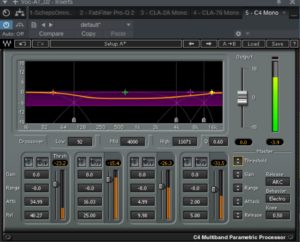First thing EQ
For a starting EQ I put a low cut of 170Hz to every vocal channel. Might need to add a cut (dip) of 250Hz and 500Hz of about 2db (see graph below) to see if Vocals clean up. This would be my starter EQ. Then I would boost the 250hz to +6db and change the frequency around to find the offending frequency (then cut it). I would do the same for the 500hz cut, make it a 10db boost and move the frequency around until I found the frequency that sounds the worst. Then I would make the cut at that frequency. If none of the frequencies sound like there isn’t really harsh then move it to flat and don’t do anything to it. Listen to a reference track (from iTunes. etc.) of a song with a lead vocal EQ that you want your vocal EQ to sound like. Then A/B them until you your vocal EQ sounds like your reference tack EQ. When you first start out mixing, this is the best way to get going in the right direction. Some mic don’t need much EQing, so use your ears. If there is something that you don’t like then keep changing the EQ until you get it. The De-esser may need to be used too fix the harshness of a vocal.
Melodyne
I use Melodyne (Assistant version) to fix the volume of every note. To make it a musical phrase. It’s better to fix the dynamics on the raw wave form before you compress it. Then I fix the pitch of every note if it needs it.
Compression
I use a 3.5:1 ratio (This is transparent and is the same ratio as a Universal Audio LA-2A, which is the most sought after Vocal compressor in the Studio) and change the threshold until the Vocal is smooth. You can take the signal reduction to around 10db at the loudest part or less. I like the “Universal Audio 1176 Blue” compressor for a rock type voice compressor. Waves.com and “Universal Audio” both have a good plugin for them.
De-essing
When you compress a lot then you need a De-essor to take the harshness away. That’s because when you listen to someone singing loud or soft, the sibilance (frequency around 6k Hz) is the same volume. So if you increase the volume for the voice with a compressor, you need to decrease the volume of the frequencies over 5K so that it will not sound harsh. My favorite De-essor is the New Scheps Omni Channel by Waves. Also this plugin lets you warm up the sound with a harmonic distortion on the “Pre”.
Multiband on the end of the channel strip
The C4 makes it more professional. The best new mixing board now have multiband compressors on all channels like the new Digico boards. If you do a test you will see that it makes the sound more professional sounding.





